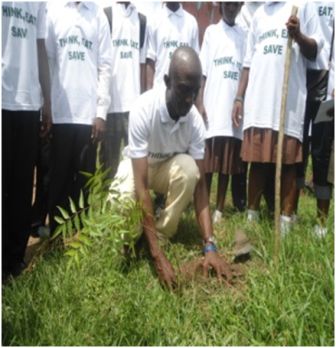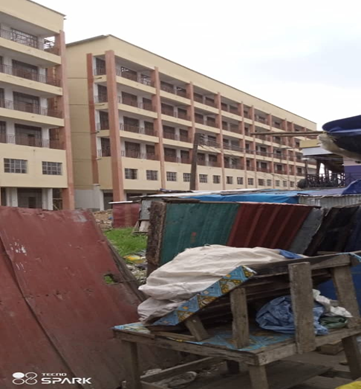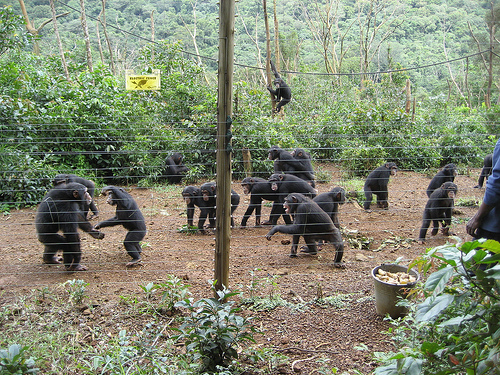‘Ernest’ Warns Investors… Need for ‘Mass Tourism Education’ in Salone
The Oswald Hanciles Column
On the 3rd of April, 2013, the President of the Republic of Sierra Leone, H.E. Ernest Bai Koroma, issued a stern warning to ‘investors’ that would be granted land leases by government to spawn some marketable investment – from tourism to mining – but, would fail to utilize such lands for legally agreed purposes; he said that government reserves the right to repossess such lands, because it is obvious those who have not developed these lands lack the “technical and financial capacity to do so”. This was during the launching of Sweet Salone’s The Place luxury resort on the idyllic Tokeh beachfront in the Freetown peninsular. President Koroma praised Sweet Salone for being “the first serious investor in tourism” from 2007 – during his first term in office – to the present. The President’s blend of praise and tough talk was ‘fallamakata-ed’ (emulated) by his land/environment minister, Musa Tarawally. The latter said that Sierra Leone is determined to give every encouragement to foreign investors; and issued a caustic warning to not only questionable foreign investors, but, also citizens who are like cancerous cells on the environment – “land grabbers and squatters”. Minister Tarawaly said that government would ensure “healthy and proper use of land”, so that “meaningful investment …won’t be strangled”.
Construction of Mansions above the ‘Green Line’ – with Impunity!!
Last week, I went to one of my paternal villages, Gloucester (my father, Ethelbert Hanciles. was born in Bonthe; but, my grandfather, V. Hanciles, was born and bred in Gloucester, and went to work in Bonthe in the early 20th Century, where he died and was buried). Gloucester is one of the first mountain villages where slaves freed in the Americas, bundled to Britain, repatriated to ‘Freetown’, settled in… at the end of the Protracted Holocaust of the Atlantic Slave Trade in the late 18th Century. My nephew resident in Gloucester, Frederick Hanciles, guided me as I directed video recording with a Freetown-based film company, Studio J (owned by French Jew, Charles Ostrov). Environmental degradation in Gloucester is chilling, and criminal. There is an ‘environmental law’ in Sierra Leone which forbids any development – for building or farming – on the mountains above the ‘green line’. (That is just about the middle of the mountain from the bottom). But, in Goderich, on nearly all the mountain ranges, developers and farmers have gone way above the ‘green line’ – in some areas, right to the peak of these mountains, wantonly destroying the rich tropical forests, exposing the bare rocks underneath them.
What these land grabbers are doing in Creole villages like Gloucester (and, the ‘collective village’ of all Sierra Leoneans) would be deemed by deep thinkers as worse than what the white man in America/Europe did when they enslaved the fore-parents of these Creoles in the Americas for over three hundred years. The land grabbers are simply putting fire on the forests to clear the land. The loss of invaluable biological life that results would make ardent environmentalists wail nonstop for ten years at the magnitude of such loss unfolding. Sierra Leone has lost over 95 percent of its virgin tropical rainforests. The tropical rainforests in these Creole villages are the few remaining with largely intact tropical rainforests. About 60 percent of plant and animal life remaining on earth can be found in such tropical rainforests. Over 65% of the ‘raw materials’ for the billions of dollar global pharmaceutical industries are found in such forests. Even locally, a large number of herbalists depend on these forests as the only ones remaining in Sierra Leone from which they can extract herbs from. These forests have been saved from being ravaged by subsistence farmers with their slash-and-burn farming methods, and by mineral companies in their rapacious drive for profit, because they are on treacherously mountainous terrain. No more. The rich land grabbers, lured by the scenic beauty of having their mansions on these mountainous areas, are defying all odds, spending three times more money to build their mansions on these mountains than if it were on flat ground, and causing irreversible and miasmic damage to the Creole (and national) heritage.
The Alarming Bio-Diversity Loss
Last week, I led youth from the Coalition of University Students’ Activists, and Youth Arise!!!, to get edification from Dr. Sheka Kamara of the Biological Sciences Department of Fourah Bay College, University of Sierra Leone, on the Western Area Peninsular Forest Reserve (WAPFoR). WAPFoR, occupying the centre of the peninsula, covers about 17,000 hectares of closed forest. WAPFoR hosts a range of hills with a highest peak at 971 meters. There is alarming ecological degradation ongoing in the WAPFoR.
Dr. Kamara told us that “biodiversity loss apart”, these forests serve as “water catchment” areas for nearly all the about 2 million people living in the Freetown peninsular. In simple words, the water that flows into dams, and small rivers, where most people get their water from to drink and cook food with, and wash clothes, etc. come from these forests. You destroy the forests in these mountains and you starve people of water in nearly all of Freetown. Already, in most of Freetown, there is severe already water shortage. This results not only in serious dehydration, but, most of the common diseases in Freetown today – cholera and typhoid – are contracted through unmoving almost-dried-up streams, or, people coming from toilet and not having water to wash their hands.
In the survey costing $40,000, Dr. Sheka Kamara’s university team just last year tried to measure the quantum and quality of plant and animal life in just two percent of land area of the WAPFoR. They discovered 128 species of trees; and 58 species of undergrowth. The highest number of these families are called ‘legumimosae’. The Kent village forest has the lowest numbers of species – whilst the forest around No 2 River has the highest number of species. The forest in the Kossoh Town area has the highest species diversity. Regent village area – where the new United States embassy is located; and, which is the ‘in place’ for the burgeoning elite – has an alarming single species that is endemic to it: that compares with NINE SPECIES endemic to No 2 River, where the elite have not started building their houses yet. They were able to discover 160 species of birds – with 120 of these species ‘resident species’. (While some were ‘migratory birds’, coming from distant Europe). There is good news: most of the forests are still in the Guinea Congo Biome stage – a reason why there are still such appreciable diversity of birds.
Biologist, G. D. Field, carried out work in the 1960s and early 1970s and recorded 316 species of birds. In 1990, Ausden and Wood recorded 186 species over a period of three months. A total of 374 species, including occasional vagrants and migrants that visit water bodies within the forest, were recorded.
Before the ‘rebel war’ of the 1990s, before the elite in Freetown started rushing to construct their mansions on the mountains of Freetown as if there was a ‘gold rush’, one could easily bump into many species of mammals in the forests of Freetown. Authoritative studies done twenty years ago revealed that these mountains harbour over 50 species of mammals, of which seven species are primates, five of which were threatened even then – Western chimpanzee (En), Red Colobus monkey (Vu), Black-and-White Colobus Monkey, Sooty Mangabey (NT) and Diana monkey (Vu). Other threatened mammals include Leopard (Vu), Jentink’s Duiker (Vu), Black Duiker (NT) and Maxwell Duiker (NT). An endemic toad Cardioglosus aureolli could also be found. Dr. Sheka Kamara’s survey in 2012 could only identify 7 mammals – monkeys, squirrels, etc.
Management of the forests is now ‘National Security’ Matter
The management of the forest reserve is the mandate of the Forestry Division of the Ministry of Agriculture, Forestry and Food Security (MAFFS). The reserve was declared in 1916 and gazetted a non-hunting forest reserve in 1973. The conservation of WAPFoR has been identified as an issue of National Security by H.E. Ernest Bai Koroma, President of Sierra Leone. In 2011, President Koroma’s government approved a revised demarcation line and protection mechanism of WAPFoR. The APC-majority Parliament is considering the declaration of “Nature Park Western Area”. Before his first term ended, President Koroma ordered the establishment of a Presidential Task Force to ensure long-standing environmental protection of the Reserve. This consisted of MAFFS, Ministry of Lands, Country Planning and Environment ministry (MLPCE), Environmental Protection Agency (EPA-SL) and Ministry of Electricity and Power (MEP), Ministry of Culture and Tourism, and the Office of National Security (ONS). There are debates ongoing for the establishment of a Forest Protected Area Authority. The touristic and cultural assets of the Western Area Peninsula are managed by the department of culture in the tourism ministry; and the National Tourist Board; and the villages in the reserve area. All this appears to be mere semantics, given the flagrant land grabbing perpetuated today in these mountains. So much so that the forest guards last month told the German-born Manager of the WAPFoR that there is absolute need for military assistance.
Tourism Potential will be Destroyed if we don’t Conserve the Forests
Last week, the Deputy Minister of tourism/culture, Kadie Sesay, along with NASSIT Director-General, Sam Bangura, National Tourist Board’s Cecil Williams, apparently taking a cue from the President’s warning at Tokeh Beach, went to inspect hotels being constructed under the aegis of world’s leading hotel chains – Cape Sierra (Hilton) and Mamie Yoko (Redisson Blu). (Details on this in subsequent articles). One thing that is clear to me is that there must be massive sensitization of all the citizenry, especially in Freetown, to develop a ‘Tourism Culture’ here. Destroy the forests in WAPFoR and all the millions of dollars being spent to construct five star hotels – and the opportunities for yearly billions of dollars income; and thousands of jobs being created – would come to go up in smoke.
Oswald Hanciles, Freetown
Stay with Sierra Express Media, for your trusted place in news!
© 2013, https:. All rights reserved.





